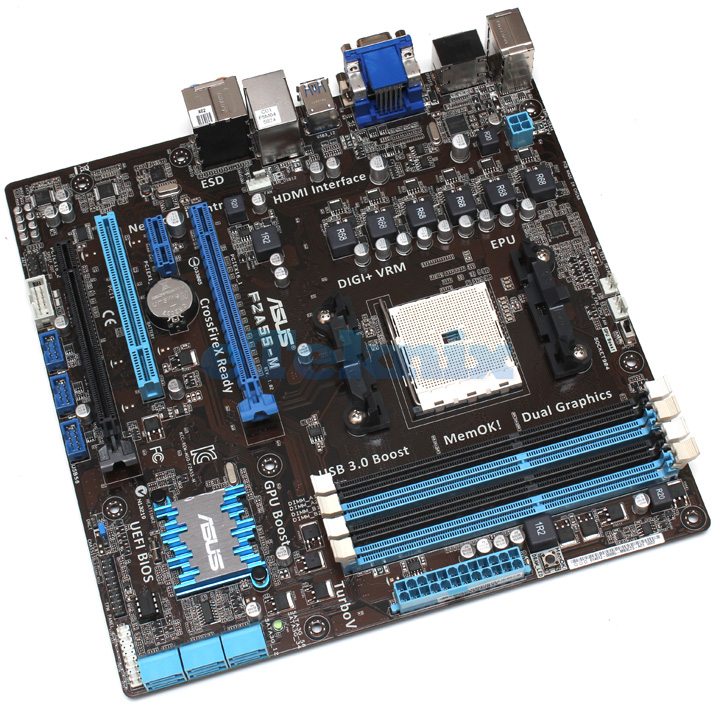Asus F2A55-M (A55) Motherboard Review
Andy Ruffell / 12 years ago
Taking a first look at the board, you’ll straight away see that we have a Micro-ATX form factor board sporting the dark brown/black PCB and blue contrasting colour scheme which is starting to grow on me a bit more than when Asus first adopted it. Due to the different blues, the black and white it does look a bit of a mish mash but hopefully the Asus design team are still learning and improving things as time goes on.

Focussing on the top end of the board, we can see a single 4-pin CPU power connector and a very bare CPU socket area. As this board uses the A55 chipset and isn’t aimed at the extreme clocker, we find no heatsinks or cooling around the processor area. This by all means doesn’t mean that you won’t be able to overclock, but performance may be hindered slightly due to the board having no cooling solution here.
Also at the top you’ll find that near the two fan headers is a GPU boost switch, which helps to overclock the iGPU, which is perfect for the new Trinity APUs that this board is aimed to work with.

Further down the board, we do find some form of cooling over the A55 chipset with the standardized Asus styling and branding. The colour scheme used on the heatsink works really well and we can only wish they could match the rest of the board with this.

Moving north from here, we find four DIMM slots that support up to a whopping 64GB of DDR3 with speeds of 1066MHz all the way up to a supported 1866MHz, but obviously can be taken further by the use of overclocking. Also around here we find a MemOK! button and the 24-pin ATX power connector.

Moving over to the opposite corner, we can see we’ve got two PCI-Express x16 slots, a PCI-Express x1 slot and a legacy PCI slot. The reasoning behind the different coloured PCI-Express x16 slots is down to the top slot running at x16 speeds, while the bottom slot runs at x4 speeds.

Just down from here is our range of headers which from left to right include audio headers, COM port, three USB 2.0 headers, clear CMOS jumper, TPM connector and the typical front panel headers for your chassis lights and buttons. Sadly no native USB 3.0 internal header but for a board of this calibre, it’s not really expected.

Just on the corner of the board are six brightly coloured blue SATA ports. All six of these SATA ports support SATA II 3Gb/s speeds and support RAID 0, 1, 10 and JBOD and work through the A55 chipset from AMD.

Finishing things off with the rear I/O panel, we can see that we have a total of four USB 2.0 ports, a PS2 mouse/keyboard combo port, optical SPDIF and a variety of display connectors including HDMI, VGA and DVI. There are also two USB 3.0 ports, a Gigabit LAN port and six jack-sensing audio connectors.
The audio on this board is supported by the Realtek ALC887 8-channel high definition audio codec, while the LAN utilises the Realtek 8111F controller. The USB 3.0 ports are run through the ASMedia ASM1042 controller, while the USB 2.0 ports (internal and external) use the A55 chipset from AMD.




















